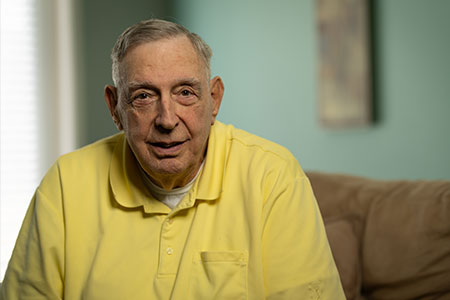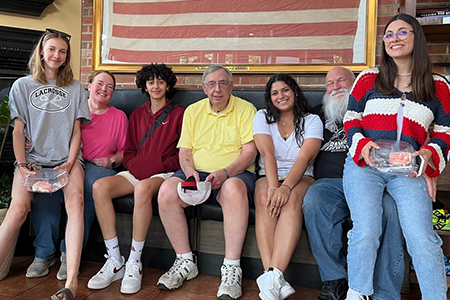Making the Right Call
Mike Shutler had his first abdominal aortic aneurysm experience after getting worked up during a board meeting.
 “I was chairman of the board of a credit union, and they had called a special meeting,” says Mike, 80, who lives in Jackson. “I was getting heated, and the Vice Chair said ‘Mike, sit down, you’re making me nervous,’ I set my coffee down, and the next thing I know I’m lying on the floor.”
“I was chairman of the board of a credit union, and they had called a special meeting,” says Mike, 80, who lives in Jackson. “I was getting heated, and the Vice Chair said ‘Mike, sit down, you’re making me nervous,’ I set my coffee down, and the next thing I know I’m lying on the floor.”
He was rushed to a local ER, and then helicoptered to another one, where the surgical team repaired his aortic aneurysm.
The aorta is the largest artery in the body, and it runs from the heart down to the abdomen, supplying blood to the body. When the wall of this blood vessel weakens, it can form an aneurysm, or bulge. If it ruptures, it can cause potentially fatal internal bleeding.
Mike was no stranger to health issues, including undergoing a triple bypass surgery at one point and taking regular insulin injections for his Type 2 diabetes. But this first aneurysm was a shock.
A series of aneurysms
“That was about five years ago, and it started the ball rolling,” Mike says.
Two years after that, Mike had aneurysm surgery on his left groin at a local hospital. And then a little over a year ago, he developed one on his right side. For this one, he was taken by ambulance to Henry Ford Hospital in Detroit, where Timothy Nypaver, M.D., a vascular surgeon at Henry Ford Health, performed his procedure.
After all of his surgeries, Mike thought he was good. Until summer 2023, when he was told by a local physician that he had another aneurysm, this time in his chest region.
“He told me that to do that operation, they would need to close off my kidneys,” Mike says. “I didn’t want to do that, so I decided to wait.”
Until he couldn’t.
It was the end of July 2023, and Mike was home alone since his wife lives in a local care facility.
“I went to bed, took my pills and was feeling pretty good,” Mike says. “I put on my pajamas, laid in bed to watch TV, and suddenly I started sweating like a stuck pig. I haven’t sweat like that since I worked as a Little League umpire, and I did a baseball game in 95 degree temps that went into overtime. I should have called 911, but it’s a guy thing.”
Instead, he called one of his daughters, who lives nearby in Holt. She called 911, then called Mike’s other daughter, who was in town visiting.
An innovative procedure
“The next thing I knew, an EMS team, a gurney and my daughter are all coming down my hallway,” Mike says. “They took me to Henry Ford Jackson Hospital and did some tests on me, then rushed me to Henry Ford Hospital again, where Dr. Nypaver remembered me.”
Mike was initially placed in a small ER room, before being wheeled out for some tests.
“When they brought me back, they put me in a much bigger room,” Mike says. “My daughter asked why, and they told her they needed room for the crash cart.”
 Mike’s condition was critical. His latest aneurysm—a suprarenal thoracoabdominal aneurysm—had ruptured and was bleeding. His team would need to operate immediately, but they felt that he wouldn’t survive a standard open surgical repair.
Mike’s condition was critical. His latest aneurysm—a suprarenal thoracoabdominal aneurysm—had ruptured and was bleeding. His team would need to operate immediately, but they felt that he wouldn’t survive a standard open surgical repair.
Instead, Dr. Nypaver and his team performed a complex, minimally invasive procedure known as a fenestrated-branched endovascular aneurysm repair (F/BEVAR). This involves placing a custom stent graft (a tubular support device). Blood flows through the graft, reinforcing the aorta and relieving pressure on the aneurysm’s wall to help prevent future ruptures. Mike’s graft also included fenestrations, or openings, that align with the kidney arteries. These custom openings are based on a person’s anatomy, and are designed to match each artery’s size, exact location and angle at which it branches from the aorta.
Custom stent grafts can take weeks to develop. However, in emergency cases such as Mike’s, Henry Ford vascular surgeons can modify a ready-made graft to fit it to a person’s specific anatomy.
“They basically had to construct a fake artery,” Mike says. “I was in my procedure for 7 hours.”
With the fenestrated and branched endograft in place, Mike’s vascular team was able to preserve Mike’s renal (kidney) artery, superior mesenteric artery (a branch of the aorta that supplies blood to the pancreas and parts of the small and large intestines) and his celiac artery (also known as the celiac trunk), which provides blood to the upper abdominal organs.
Getting back in the swing of things
 “I don’t remember much of my ER and procedure experience, but I do remember waking up after it,” Mike says. “I felt good, and I wasn’t in any pain.”
“I don’t remember much of my ER and procedure experience, but I do remember waking up after it,” Mike says. “I felt good, and I wasn’t in any pain.”
Mike’s F/BEVAR procedure was a success, but he needed to stay in the hospital, mainly bedridden, for a few weeks while he healed. After leaving Henry Ford Hospital, he entered a local rehabilitation center, where he learned how to use his muscles again and practiced activities of daily living, such as getting in and out of a car.
“After I got out of rehab, they sent me home with a physical therapist, occupational therapist and a visiting nurse,” Mike says. “Now I’m down to just the nurse.”
He recently had a follow-up with Dr. Nypaver, who told him he’s doing well. Mike has also learned that his grandfather died from an abdominal aortic aneurysm. Given that this can be an inherited condition, Mike’s three brothers have since been tested, but fortunately none of them have it.
Months after his procedure, Mike’s grateful to be getting back to his life.
“I spend most of my free time visiting my wife,” Mike says. “But I’m also active with my church. I’m Catholic and am in the Knights of Columbus. I’m sure my Henry Ford team had some help from up above.”
He doesn’t have any restrictions, although he did have to stop umpiring—a passion that culminated in being named Little League Volunteer of the Year at one point—because he has developed macular degeneration.
“I told them umpires are supposed to be blind,” Mike says.
As for his treatment experience with Henry Ford, he’s thankful for everything his team has done for him.
“They did a fabulous job taking care of me,” Mike says. “It’s a condition that many people don’t make it through, and I can’t say enough about my team. With all the times I’ve been to Henry Ford, I tell people I’m working on frequent flyer miles with them.”
.svg?iar=0&hash=F6049510E33E4E6D8196C26CCC0A64A4)

/hfh-logo-main--white.svg?iar=0&hash=ED491CBFADFB7670FAE94559C98D7798)
